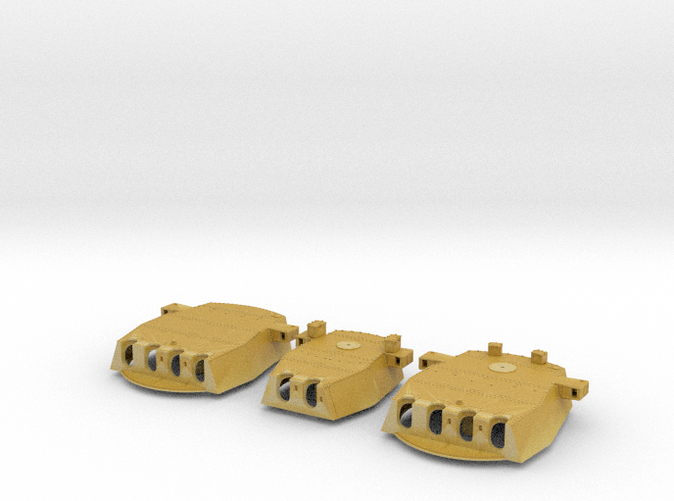1/350 Scale HMS Duke of York 14" (35.6 cm) Mark VII Turrets only specially for anyone wishing to convert the Tamiya Prince of Wales or KGV into HMS Duke of York using the Pontos Set Brass Barrels . These are highly detailed parts modelled using plans and many reference photographs for the most accurate and detailed 14" (35.6 cm) Mark VII Turrets available. If not using the Pontos Brass Barrel set then you will need the Micro Master Barrel set: http://shpws.me/Pkuy- 3x Turrets
- Accurate armour thickness on all faces.
- Accurate B turret roof armour (covered whole roof, unlike part covered as depicted in most kits)
- Modelled with detailed Ammo Lockers in place for B and X Turret Pom Poms
- Accurate sighting ports, rivets, hatches and Rangefinders
- Highly detailed and accurate parts, modelled from plans and photographic reference.
- Barrels are NOT included as this set is specifically for the Pontos Set.
- details include Hex nuts, accurate Rivet placement, Open Sighting ports
- Each Turret has Mounting specially made to hold the Pontos Brass Barrels.
Despite its Mark number, this was actually the first 14" (35.6 cm) gun that was exclusively designed and accepted into service by the Royal Navy. Previous 14" (35.6 cm) naval guns had been acquired either by taking over
ships and
guns building for other nations or by importing
USA weapons.
The high-velocity heavy gun had fallen out of favor in the British Navy because of the problems experienced with the
16"/45 (40.6 cm) Mark I used on the Nelson class battleships. For this reason, the design of the new 14"/45 (35.6 cm) Mark VII reverted to the lower velocities used in guns produced before and during World War I. As a result, the muzzle velocity of the new Mark VII did not differ appreciatively from that achieved by the
14"/45 (35.6 cm) Mark I carried by the battleship Canada (ex-Chilean
Almirante Latorre) during World War I.
The decision to use 14" (35.6 cm) guns on the King George V class Battleships was made in order to comply with Treaty restrictions, despite the fact that other European powers were building ships with larger weapons. As a result, the King George V class were arguably the weakest-armed battleships built in the 1930 to 1946 time period.
The design of this gun was based upon the
12"/50 (30.5 cm) Mark XIV, which was an experimental weapon completed in August 1933 to test "all steel" construction techniques. These new 14" (35.6 cm) guns were to a no-wire, radial-expansion construction, which resulted in a stronger, lighter gun that was less likely to suffer from barrel droop. This improved design gave the British a weapon that was more accurate and had a longer barrel life than the larger 16"/45 (40.6 cm) Mark I. Unfortunately, the mountings for these weapons were prone to mechanical failures during the early part of the war, with both HMS Prince of Wales and HMS King George V having numerous problems during their engagements against Bismarck.
Many, if not most, of these problems had been corrected by 1943. During the early part of her action against Scharnhorst at the Battle of the North Cape on 26 December 1943, HMS Duke of York scored 31 straddles out of 52 broadsides fired and during the latter part she scored 21 straddles out of 25 broadsides, a very creditable gunnery performance. In total, Duke of York fired 450 shells in 77 broadsides. However, HMS Duke of York still fired less than 70% of her possible output during this battle because of mechanical and "errors in drill" problems.
In addition to those used on the battleships, a further two guns were used as coastal artillery at Dover, but their extemporized mountings were not suitable for targeting fast moving ships. These coastal guns were supplied with a supercharge, giving them a very long range.
Consisted of tapered inner A tube, A tube, jacket breech ring of rectangular external shape, breech bush located in the A tube and a shrunk collar over the A tube. Used a Welin breech block and hydraulic Asbury mechanism. Including the two trial guns, a total of 78 guns were made, 24 by the Royal Gun Factory, 39 by Vickers-Armstrong, Elswick and 15 by Beardmore. The last 46 guns produced had a different shape to the breech ring which lowered the overall weight of the gun. These latter guns used a 12.5 ton (12.7 mt) counterweight while the earlier guns used a 11 ton (11.2 mt) counterweight in order to maintain the same center of balance. The Mark VII* was a loose barrel version, but none were ever manufactured.
These were the first heavy British guns in service to recoil in a cast steel cradle rather than on slides. This was a feature first prototyped on the 12"/50 (30.5 cm) Mark XIV.
At least one gun still exists and is currently on display at the Royal Armoury located at Fort Nelson, Hampshire, UK.
Cleaning Information
Some part cleanup will be necessary. The 3D printing process uses a waxy substance to support certain part features during the printing process. Although the parts are cleaned by Shapeways, some waxy residue may remain. It can be safely removed with water and a mild aqueous detergent like "Simple Green" using an old, soft toothbrush, Q-tips or pipe cleaners. During the printing process, liquid resin is cured by ultraviolet light. Microscopic bits of resin may remain uncured.
Let your parts sit in direct sunlight for a few hours to fully cure the resin.
Water-based acrylic paints meant for plastics is strongly recommended. Other paints, especially enamels, may not cure on Frosted Detail 3D-printed plastics.
Use dedicated model sprue cutters to remove parts to minimise the risk of damage to parts.
Please take a look at my other items.
Painting tips and preparation
